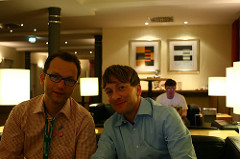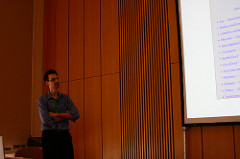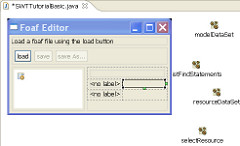This week I attended the webinale 07 conference, which circles around Web technologies. 
There were a lot of talks, where most of them had the word ajax in their title. Some of the talks where by experts on general topics, such as rapid prototyping, or by experts on very specific topics, such as their own product. I never heard anything uninteresting. It was a great place to socialize and to find possible vendors and customers. Even I, the semantic-web-is-no-business-yet freak, had some interesting lunchbreak meetings. Two students with whom I worked were also there, by chance.
The social event on tuesday evening – dubbed “webinale at night” – was organized perfectly, good food, professional DJ, enough alcohol. Only the rule of “have 50% women at an event” was severly broken, we need more women in information business and science. Very positive on the social event: no boring speech before the buffet was opened, it was all socializing.
My own talk was about – Semantic Desktop. I included a few slides about RDF and triples and RDFS and how simple and restful everything is up front, a one minute crash-course in Semantic Web. They are not perfect, but good enough to kickstart a few brains out there to think about the future of their data. Nepomuk was trimmed down to one slide this time, and I skipped most of the gnowsis slides while presenting. Maybe someone took pictures of my talk, add comments here if you did…
My slides are for download here:
I met Benjamin Nowack at the conference, his talk was about Semantic Web and Web 2.0:

There were many cool people like Ben Ramsey:
and people with suits that know how to make serious money. I was specially impressed by Florian Müller from CTP who seems to have the skills to do projects professionally, quickly, without causing too much stress on everyone, and probably for serious money.

Christoph Janz from pageflakes.com held an, I would say, “oscar-nominated” powerpoint presentation about their website, with much humor and feature details.
 .
.
Everyone wore crazy t-shirts, and was somehow working in it business. 
Bengee gave his talk about RDF and stunned everybody with the great powers at hand (and with too much technical details, in my opinion)

The only real sucker at the conference was the laaaaaaaaaaaaaagging internet connection. A lame setup of about 10 different wireless networks, of which some may work, some not, but surely not for hours, made it a never-ending quest for online time.
being online on a random base sucked a for me only a litte, but much for the Microsoft Keynote speaker who wanted to present the new Microsoft Online Platform. Well, without web, thats a show-stopper. It took the admins a few minutes to get him online, after he was disconnected. Nevertheless, Paramesh Vaidyanathan is a professional keynoter and kept our attention during the lag.

So, if someone has a business for doing good wifi at conferences, here is your customer.
For me, the last talk was a “framework smackdown” where some major web frameworks were compared. Rails, JSF, GWT, Pylons, qooxdoo, Ruby-On-Rails, Flex, Zend. 
The message for me was: they are all ok, the free ones are harder to use, and the big players don’t care so much for web standards. Doing a whole website with flash seems perfectly ok for some companies.
Anyway, next year they are going to do the conference again, and if you are in the web business in germany, you may want to go there. Not only to know about the latest and best ROI web frameworks, all the big players in the web industry are there, but also to get connected to people you wouldve not expected.
Software and Support Publishing House also does other conferences in Germany, so you better check out their conference website. They are a major publisher of magazines, like the php magazine, eclipse magazine, .Net, etc etc. you hack it, they have it.
















